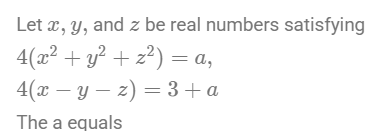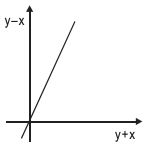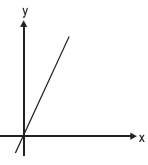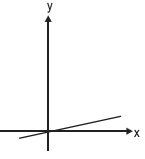CAT Quantitative Ability Questions | CAT Algebra questions
Algebra Questions for CAT | Past Year CAT Algebra Questions | Elementary Algebra; Algebraic Expressions; Basic Rules of Algebra; Equations and Solutions; Equation involving Fractional Expressions; Polynomial Equations; Equations with Fractions or Absolute Values; Simplifying Radicals; Rational Exponents; Problems Based on Ages, Sequence and Series; Sum of Numbers; Logarithm; Arithmetic Geometric and Harmonic Mean; Progressions.CAT/2024.2(Quantitative Ability)
Question. 15
A company has 40 employees whose names are listed in a certain order. In the year 2022, the average bonus of the first 30 employees was Rs. 40000, of the last 30 employees was Rs. 60000, and of the first 10 and last 10 employees together was Rs. 50000. Next year, the average bonus of the first 10 employees increased by 100%, of the last 10 employees increased by 200% and of the remaining employees was unchanged. Then, the average bonus, in rupees, of all the 40 employees together in the year 2023 was
CAT/2024.2(Quantitative Ability)
Question. 16
A vessel contained a certain amount of a solution of acid and water. When 2 litres of water was added to it, the new solution had 50% acid concentration. When 15 litres of acid was further added to this new solution, the final solution had 80% acid concentration. The ratio of water and acid in the original solution was
468
CAT/2023.3(Quantitative Ability)
Question. 32
The number of coins collected per week by two coin-collectors A and B are in the ratio 3 : 4. If the total number of coins collected by A in 5 weeks is a multiple of 7, and the total number of coins collected by B in 3 weeks is a multiple of 24, then the minimum possible number of coins collected by A in one week is
42
15
967
19
CAT/2022.3(Quantitative Ability)
Question. 57
The arithmetic mean of all the distinct numbers that can be obtained by rearranging the digits in 1421, including itself, is
150
CAT/2022.3(Quantitative Ability)
Question. 58
A donation box can receive only cheques of ₹100, ₹250, and ₹500. On one good day, the donation box was found to contain exactly 100 cheques amounting to a total sum of ₹15250. Then, the maximum possible number of cheques of ₹500 that the donation box may have contained, is
12
CAT/2022.3(Quantitative Ability)
Question. 59
The average of all 3-digit terms in the arithmetic progression 38, 55, 72, ..., is
548
14
14
12
47
44
34
82
CAT/2022.1(Quantitative Ability)
Question. 81
In a class of 100 students, 73 like coffee, 80 like tea and 52 like lemonade. It may be possible that some students do not like any of these three drinks. Then the difference between the maximum and minimum possible number of students who like all the three drinks is
99
CAT/2021.3(Quantitative Ability)
Question. 91
The arithmetic mean of scores of 25 students in an examination is 50. Five of these students top the examination with the same score. If the scores of the other students are distinct integers with the lowest being 30, then the maximum possible score of the toppers is
92
CAT/2020.2(Quantitative Ability)
Question. 97
The number of pairs of integers(x,y) satisfying x ≥ y ≥ -20 and 2x + 5y = 99 is
17
CAT/2020.2(Quantitative Ability)
Question. 99
If x and y are non-negative integers such that x + 9 = z, y + 1 = z and x + y < z + 5, then the maximum possible value of 2x + y equals
23
CAT/2020.2(Quantitative Ability)
Question. 102
Aron bought some pencils and sharpeners. Spending the same amount of money as Aron, Aditya bought twice as many pencils and 10 less sharpeners. If the cost of one sharpener is 2 more than the cost of a pencil, then the minimum possible number of pencils bought by Aron and Aditya together is
CAT/2019.2(Quantitative Ability)
Question. 114
If 5x - 3y = 13438 and 5x-1 + 3y+1 = 9686 , then x+y equals
13
CAT/2018.2(Quantitative Ability)
Question. 120
If a and b are integers such that 2x2 − ax + 2 > 0 and x2 − bx + 8 ≥ 0 for all real numbers x, then the largest possible value of 2a − 6b is
36
CAT/2017.1(Quantitative Ability)
Question. 125
For how many integers n, will the inequality (n – 5) (n – 10) – 3(n – 2) ≤ 0 be satisfied?
11
CAT/2005(Quantitative Ability)
Question. 136
A telecom service provider engages male and female operators for answering 1000 calls per day. A male operator can handle 40 calls per day whereas a female operator can handle 50 calls per day. The male and the female operators get a fixed wages of Rs. 250 and Rs. 300 per day respectively. In addition, a male operator gets Rs. 15 per call he answers and a female operator gets Rs. 10 per call she answer. To minimize the total cost, how many male operators should the service provider employ assuming he has to employ more than 7 of the 12 female operators available for the job?
CAT/2002(Quantitative Ability)
Question. 174
Three pieces of cakes of weight 4(1/2) lbs, 6(3/4) lbs and 7(1/5) lbs respectively are to be divided into parts of equal weights. Further, each part must be as heavy as possible. If one such part is served to each guest, then what is the maximum number of guests that could be entertained?
CAT/2002(Quantitative Ability)
Question. 177
Amol was asked to calculate the arithmetic mean of ten positive integers each of which had two digits. By mistake, he interchanged the two digits, say a and b, in one of these ten integers. As a result, his answer for the arithmetic mean was 1.8 more than what it should have been. Then b – a equals
CAT/2002(Quantitative Ability)
Question. 178
A child was asked to add first few natural numbers (that is, 1 + 2 + 3 + .....) so long his patience permitted. As he stopped he gave the sum as 575. When the teacher declared the result wrong the child discovered he had missed one number in the sequence during addition. The number he missed was
CAT/2001(Quantitative Ability)
Question. 181
Two men X and Y started working for a certain company at similar jobs on January 1, 1950. X asked for an initial salary of Rs 300 with an annual increment of Rs 30. Y asked for an initial salary of Rs 200 with a rise of Rs 15 every six months. Assume that the arrangements remained unaltered till December 31, 1959. Salary is paid on the last day of the month. What is the total amount paid to them as salary during the period?
CAT/2001(Quantitative Ability)
Question. 186
Ujakar and Keshab solve a quadratic equation. Ujakar made a mistake in writing down the constant term. He ended up with the roots (4, 3). Keshab made a mistake in writing down the coefficient of x. He got the roots as (3, 2). What will be the exact roots of the original quadratic equation?
Comprehension
Directions for questions: Read the information given below and answer the questions that follow :
The batting average (BA) of a test batsman is computed from runs scored and innings played - completed innings and incomplete innings (not out) in the following manner :

Comprehension
Directions for questions: Read the information given below and answer the questions that follow :
The batting average (BA) of a test batsman is computed from runs scored and innings played - completed innings and incomplete innings (not out) in the following manner :

CAT/2001(Quantitative Ability)
Question. 191
For a Fibonacci sequence, from the third term onwards, each term in the sequence is the sum of the previous two terms in that sequence. If the difference in squares of seventh and sixth terms of this sequence is 517, what is the tenth term of this sequence?
CAT/2000(Quantitative Ability)
Question. 193
A, B and C are 3 cities that form a triangle and where every city is connected to every other one by at least one direct roots. There are 33 routes direct & indirect from A to C and there are 23 direct routes from B to A. How many direct routes are there from A to C ?
CAT/1999(Quantitative Ability)
Question. 199
The expenses of a boarding school depends upon the fixed cost and variable cost. Variable cost varies directly as the number of students. If the expenses per student were Rs 600 for 50 students and Rs 700 for 25 students then what are the expenses for 100 students?
Comprehension
Directions for Questions: These questions are based on the situation given below :
There are fifty integers a1 , a2 , ....... a50, not all of them necessarily different. Let the greatest integer of these fifty integers be referred to as G, and the smallest integer be referred to as L. The integers a1 through a24 form sequence S1, and the rest form sequence S2. Each member of S1 is less than or equal to each member of S2.
Comprehension
Directions for Questions: These questions are based on the situation given below :
There are fifty integers a1 , a2 , ....... a50, not all of them necessarily different. Let the greatest integer of these fifty integers be referred to as G, and the smallest integer be referred to as L. The integers a1 through a24 form sequence S1, and the rest form sequence S2. Each member of S1 is less than or equal to each member of S2.
CAT/1999(Quantitative Ability)
Question. 202
There are fifty integers a1 , a2 , ....... a50, not all of them necessarily different. Let the greatest integer of these fifty integers be referred to as G, and the smallest integer be referred to as L. The integers a1 through a24 form sequence S1, and the rest form sequence S2. Each member of S1 is less than or equal to each member of S2.
Every element of S1 is made greater than or equal to every element of S2 by adding to each element of S1an integer x.Then x cannot be less than
Comprehension
There are m blue vessels with known volumes V1, V2,....., Vm arranged in ascending order of volumes, where V1 is greater than 0.5 litres and Vm is less than 1 litre. Each of these is full of water. The water is emptied into a minimum number of white empty vessels each having volume 1 litre. If the volumes of the vessels increases with the value of lower bound 10–1 .
Comprehension
There are m blue vessels with known volumes V1, V2,....., Vm arranged in ascending order of volumes, where V1 is greater than 0.5 litres and Vm is less than 1 litre. Each of these is full of water. The water is emptied into a minimum number of white empty vessels each having volume 1 litre. If the volumes of the vessels increases with the value of lower bound 10–1 .
Comprehension
There are m blue vessels with known volumes V1, V2,....., Vm arranged in ascending order of volumes, where V1 is greater than 0.5 litres and Vm is less than 1 litre. Each of these is full of water. The water is emptied into a minimum number of white empty vessels each having volume 1 litre. If the volumes of the vessels increases with the value of lower bound 10–1 .
CAT/1998(Quantitative Ability)
Question. 207
You can collect Rubies and Emeralds as many as you can. Each Ruby is worth Rs 4crores and each Emerald is worth of Rs 5crore. Each Ruby weights 0.3 kg. and each Emerald weighs 0.4 kg. Your bag can carry at the most 12 kg. What you should collect to get the maximum wealth?
CAT/1996(Quantitative Ability)
Question. 210
Once I had been to the post-office to buy stamps of five rupees, two rupees and one rupee. I paid the clerk Rs 20, and since he did not have change, he gave me three more stamps of one rupee. If the number of stamps of each type that I had ordered initially was more than one, what was the total number of stamps that I bought?
CAT/1996(Quantitative Ability)
Question. 213
Out of two-thirds of the total number of basket-ball matches, a team has won 17 matches and lost 3 of them. what is the maximum number of matches that the team can lose and still win three-fourths of the total number of matches, if it is true that no match can end in a tie ?
CAT/1994(Quantitative Ability)
Question. 224
Along a road lie an odd number of stones placed at intervals of 10 m. These stones have to be assembled around the middle stone. A person can carry only one stone at a time. A man carried out the job starting with the stone in the middle, carrying stones in succession, thereby covering a distance of 4.8 km. Then the number of stones is

































































































































































































